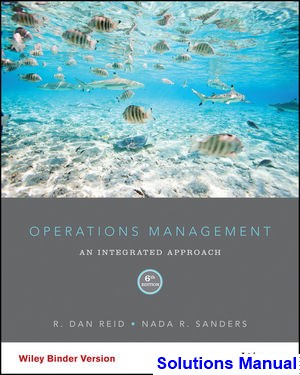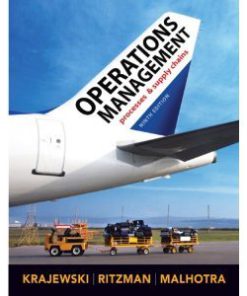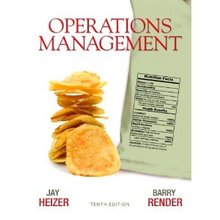Operations Management 6th Edition Reid Solutions Manual
$55.00 Original price was: $55.00.$29.99Current price is: $29.99.
Operations Management 6th Edition Reid Solutions Manual
Operations Management 6th Edition Reid Solutions Manual

Product details:
- ISBN-10 : 1118952618
- ISBN-13 : 978-1118952610
- Author: R. Dan Reid and Nada R. Sanders
Chapter 1 Introduction to Operations Management 1
What is Operations Management? 2
Differences between Manufacturing and Service Organizations 5
Operations Management Decisions 6
Historical Development 10
Today’s OM Environment 18
Operations Management in Practice 19
Within OM: How It All Fits Together 20
OM Across the Organization 20
Chapter 2 Operations Strategy and Competitiveness 28
The Role of Operations Strategy 29
Developing a Business Strategy 30
Developing an Operations Strategy 34
Strategic Role of Technology 40
Productivity 41
Operations Strategy Within OM: How it All Fits Together 45
Operations Strategy Across the Organization 46
Chapter 3 Product Design and Process Selection 54
Product Design 55
The Product Design Process 56
Factors Impacting Product Design 60
Process Selection 64
Designing Processes 67
Process Performance Metrics 69
Linking Product Design and Process Selection 72
Technology Decisions 77
Designing Services 82
Product Design and Process Selection Within OM: How It All Fits Together 86
Product Design and Process Selection Across the Organization 87
Chapter 4 Supply Chain Management 98
Basic Supply Chains 99
Issues Affecting Supply Chain Management 106
The Role of Purchasing 116
Sourcing Decisions 120
The Role of Warehouses 130
Implementing Supply Chain Management 135
Supply Chain Management Within OM: How It All Fits Together 139
SCM Across the Organization 140
Chapter 5 Total Quality Management 151
Defining Quality 152
Cost of Quality 154
The Evolution of Total Quality Management (TQM) 156
The Philosophy of TQM 160
Quality Awards and Standards 171
Why TQM Efforts Fail 174
Total Quality Management (TQM) Within OM: How It All Fits Together 175
Total Quality Management (TQM) Across the Organization 175
Chapter 6 Statistical Quality Control 185
What Is Statistical Quality Control? 186
Sources of Variation: Common and Assignable Causes 187
Descriptive Statistics 187
Statistical Process Control Methods 189
Control Charts for Variables 191
Control Charts for Attributes 197
Process Capability 203
Six Sigma Quality 208
Acceptance Sampling 210
Implications for Managers 216
Statistical Quality Control in Services 217
Statistical Quality Control (SQC) Within OM: How It All Fits Together 219
Statistical Quality Control (SQC) Across the Organization 219
Chapter 7 Just-in-Time and Lean Systems 234
The Philosophy of JIT 235
Elements of JIT 237
Just-in-Time Manufacturing 241
Total Quality Management 249
Respect for People 251
Benefits of JIT 255
Implementing JIT 256
JIT in Services 258
JIT and Lean Systems Within OM: How It All Fits Together 259
JIT and Lean Systems Across the Organization 259
Chapter 8 Forecasting 267
Principles of Forecasting 268
Steps in the Forecasting Process 268
Types of Forecasting Methods 269
Time Series Models 272
Causal Models 289
Measuring Forecast Accuracy 293
Selecting the Right Forecasting Model 296
Collaborative Planning, Forecasting, and Replenishment (CPFR) 299
Forecasting Within OM: How It All Fits Together 300
Forecasting Across the Organization 301
Chapter 9 Capacity Planning and Facility Location 316
Capacity Planning 317
Making Capacity Planning Decisions 323
Decision Trees 325
Location Analysis 328
Making Location Decisions 332
Capacity Planning and Facility Location Within OM: How It All Fits Together 343
Capacity Planning and Facility Location Across the Organization 343
Chapter 10 Facility Layout 355
What Is Layout Planning? 356
Types of Layouts 356
Designing Process Layouts 360
Special Cases of Process Layout 366
Designing Product Layouts 370
Group Technology (Cell) Layouts 377
Facility Layout Within OM: How It All Fits Together 378
Facility Layout Across the Organization 378
Chapter 11 Work System Design 392
Work System Design 393
Job Design 393
Work Measurement 402
Compensation 415
Work System Design Within OM: How It All Fits Together 418
Work System Design Across the Organization 418
Chapter 12 Inventory Management 432
Basic Inventory Principles 433
Inventory Management Objectives 436
Relevant Inventory Costs 440
ABC Inventory Classification 442
Inventory Record Accuracy 445
Determining Order Quantities 446
Determining Safety Stock Levels 463
The Periodic Review System 466
Inventory Management within OM: How It All Fits Together 468
Inventory Management across the
Organization 469
Chapter 13 Aggregate Planning 483
Business Planning 484
Aggregate Planning Options 486
Aggregate Plan Strategies 490
Developing the Aggregate Plan 492
Aggregate Planning Within OM: How It All Fits Together 502
Aggregate Planning Across the Organization 502
Chapter 14 Resource Planning 517
Enterprise Resource Planning 518
The Benefits and Costs of ERP 522
Material Planning Systems 524
How MRP Works 532
Capacity Requirements Planning (CRP) 538
Resource Planning Within OM: How It All Fits Together 540
Resource Planning Across the Organization 540
Chapter 15 Scheduling 553
Basic Scheduling Concepts 554
Developing a Schedule of Operations 560
Optimized Production Technology 569
Scheduling Issues for Service Organizations 572
Scheduling Within OM: Putting It All Together 576
Scheduling Across the Organization 576
Chapter 16 Project Management 589
The Project Life Cycle 590
Project Management Concepts 591
Estimating the Probability of Completion Dates 604
Reducing Project Completion Time 606
The Critical Chain Approach 609
Project Management Within OM: How It All Fits Together 611
Project Management OM Across the Organization 611
Appendix A Solutions to Odd-Numbered Problems 625
Appendix B The Standard Normal Distribution 647
Appendix C p-Chart 648
Name index 651
Subject index 654
People also search:
operations management 6th edition
operations management an integrated approach 6th edition
om 6th edition pdf
operations management 6th edition
operations management 6th
You may also like…
Solution Manual
Operations Management in the Supply Chain Decisions and Cases Schroeder 6th Edition Solutions Manual
Solution Manual
Operations Management Stevenson 12th Edition Solutions Manual
Solution Manual
Operations Management Krajewski 9th Edition Solutions Manual
Solution Manual
Operations Management Stevenson 11th Edition Solutions Manual












